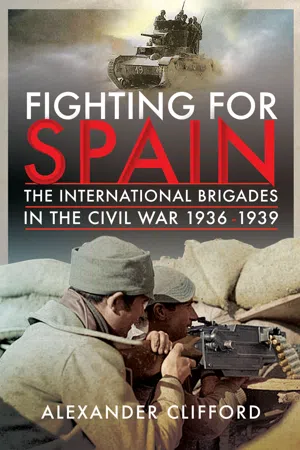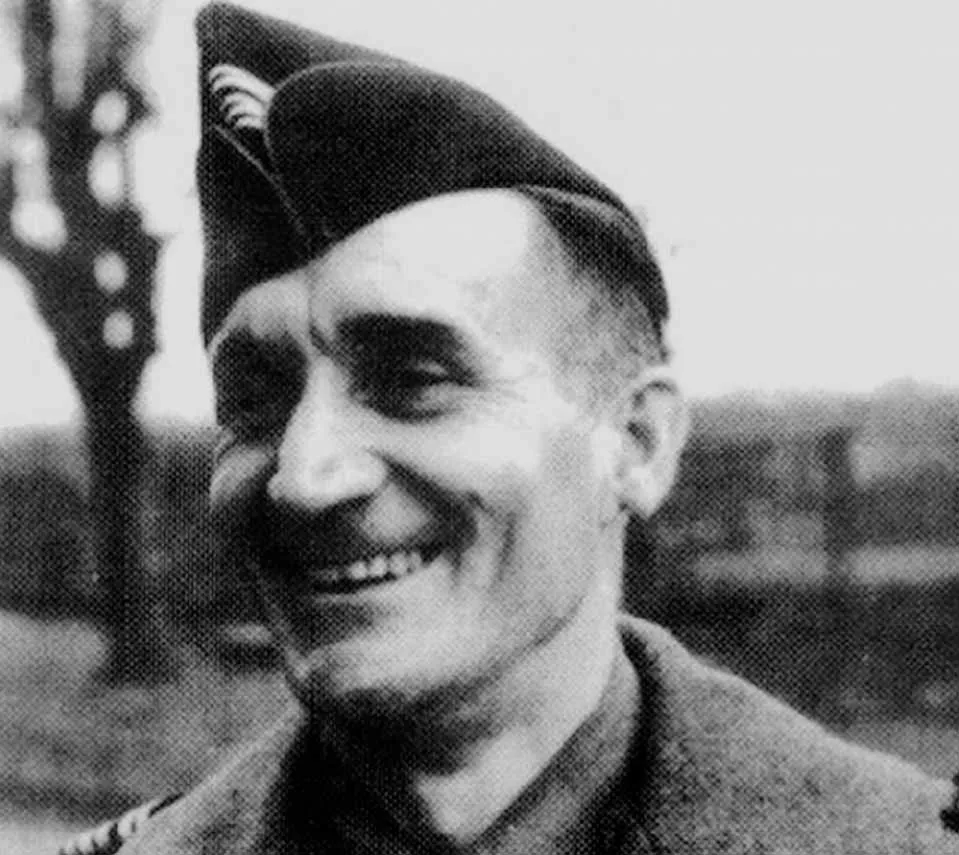![]()
Chapter 1
Antifascistas: The International Brigades
Formation and Recruitment
Following the Soviet decision to intervene in Spain in September 1936, the Comintern dispatched a number of officials, led by André Marty and Luigi Longo (known in Spain as Gallo) to organise the numerous foreign volunteers already arriving into an International Brigade. Months before, the Comintern had set aside 1,000 million francs to finance and arm a brigade of 5,000 volunteers. Eventually, more than 32,000 men from over fifty countries would serve in its ranks. Even before the creation of the Brigades, thousands had flocked to Spain to fight for the Republic. Many of the first to volunteer were athletes and activists in Barcelona at the outbreak of war for the People’s Olympiad, a left-wing protest games set up in response to the official Olympics being held in Nazi Germany that year. Next, scores of artists, writers and intellectuals, individuals with the financial and cultural capital to make an international trip, found their way to Spain. They were joined by less well-to-do volunteers, mainly from neighbouring France, many of whom were exiles from Germany, Italy and other right-wing dictatorships, who now saw a chance to fight fascism. Even before the Comintern had begun to organise the Brigades, hundreds of spontaneous volunteers had arrived in Spain, most finding their way into the disorganised but spirited worker and peasant militias created by trade unions and political parties when the Republican government made the decision to arm the people just days into the conflict. However, with infrastructure put in place by Communist parties around the world, thousands more, mainly working-class, volunteers could make the trip, even if they did not have the money or documents required. Soon, there was a steady flow of Brigaders arriving from around Europe, via Paris, where large groups were mustered and then smuggled across the French frontier. The real credit for melding the disparate, chaotic elements that found their way to Spain into the International Brigades must go to the organising efforts of Longo. He arrived to find many different groups of volunteers languishing in various barracks and militia headquarters, frustrated at their lack of action. After being fobbed off by the Republican authorities, the Spanish Communist Party offered Longo one of their militia bases at Albacete, equidistant between Madrid and Valencia. Arriving on 12 October 1936 to find no accommodation, weapons, uniforms or equipment, in less than a month Longo and other Comintern officials would have not just created a training and administrative base for the Internationals, but also founded, equipped, armed and, by a liberal definition of the term, trained, two International Brigades numbering more than 3,500 men from at least a dozen countries. Not only that, but by 12 November both brigades were in combat in the desperate defence of Madrid, where they would unquestionably fight with great courage and determination, even if they were found wanting in terms of skill and tactics, winning a heroic reputation for themselves.
Mugshot of Luigi Longo (‘Gallo’), arrested as part of Mussolini’s crackdown on political opposition. Longo would go on to become the leader of the Italian communist party in the 1960s and 1970s.
Base reports indicate that by the end of April 1938, 31,369 foreign volunteers had served in the Brigades, with the largest national groups being the French (8,778), Poles (3,034), Germans and Austrians (3,026), Italians (2,908) and Americans (2,274). There would be one final glut of arrivals in the spring and early summer of 1938 when the French government temporarily reopened the frontier and Communist parties around the globe stepped up their recruitment drives. Most scholars estimate a total of between 32,000 and 35,000 volunteers serving in the Brigades over the course of the war, although there is clearly no definitive figure and a margin of error of several thousand. Given the figure provided by the Albacete base just five months before the International Brigades were withdrawn, the lower end of the estimate seems most likely. Figure 1 shows the breakdown of the volunteers by nationality, aggregating figures from a number of modern estimates and the final report quoted above to give a rough total of 32,600 Brigaders.
Figure 1. Volunteers by nationality.
There was a whole host of reasons why volunteers went to Spain, although, as can be seen from Figure 2, many belonged to Communist or other left-wing parties and were clearly ideologically motivated. It is thought that between 60 and 75 per cent of the Brigaders were Communists, although the figure varied depending on nationality, with a higher percentage of Americans being party members than, for example, French volunteers, likely due to the differing level of commitment required for a journey across the Atlantic compared to a hop over the Pyrenees. Less than half of the Italian recruits were Communists, with significant contingents of Anarchists and Republicans in the ranks of Italian International Brigade units, showing how the allegiances of volunteers reflected to some extent the political landscape of their home country. For activists on the left around the world, from the summer of 1936 for at least a year, the Spanish Revolution and Civil War became the most important international issue; ‘Spain became your lifeblood’ remembered one Glasgow volunteer of the time before he was able to enlist. In the 1930s, a polarised age of mass mobilisation, the issue of Spain seems to have had a great impact on the popular imagination, even more so than Hitler’s seizure of power for instance. For many, both those who went to fight and those who supported the Spanish Republic in other ways, the stakes were huge; it was widely held that the advance of fascism could be checked in Spain, that Hitler and Mussolini’s expansionist ambitions could be thwarted, that no less than a world war could be avoided, if the dictators were stopped on Spanish soil. Scores of veterans held on to this misconception for decades, many until their dying days. The vast majority of volunteers had little or no understanding of the complex political events which had led to the outbreak of the civil war, as described in this volume’s Introduction. In fairness, the world press of the time would not have provided much coverage of Spanish domestic issues. What Brigaders did hear about, however, was the military rebellion of 1936 which triggered the conflict, perceived by many news outlets as an attempt to crush democracy by force. Even more exciting to countless Left-wingers were the reports that soon followed of social revolution and of workers and peasants valiantly and spontaneously defending their Republic against reactionary generals. Perhaps they also read of the brutality and terror unleashed by Franco’s armies as they advanced across Spain, murdering tens of thousands of potential opponents, most infamously in Badajoz. And the greatest spur to action of all were the widespread reports of Italian and German intervention, including stories of civilians bombed by Nazi aircraft. This was the first time air power was used against European cities on a large scale and naturally the reactions to the consequences were horror and consternation. For thousands of Leftists around the world, these stories were impossible to ignore. The rise of Hitler and Mussolini had come about without much of a fight, and both dictators were flexing their foreign policy muscles at the time, with the Western powers turning a blind eye, to the frustration of many in Britain, France, the United States and elsewhere. Here in Spain was a chance to actually fight fascism and defend democracy and revolution. The great debates of the age seemed to be being played out in combat on Spanish soil. Certainly, more than 10,000 volunteers came from nations living under authoritarianism, such as Germany, Italy, Austria, Poland, Yugoslavia and others. Some were living in political exile, while others slipped out of their home country, with stories of German Brigaders hanging on to the underside of trains crossing the French border. For both exiles and those leaving a right-wing regime to fight in Spain, there was little hope of returning home. And yet for Italians and Germans in particular, here was a chance to fight Hitler or Mussolini when they could not do so in their native countries.
Figure 2. Political affiliation of British and Irish volunteers (where given). Note: more than 500 volunteers also listed membership of a trade union. This figure has not been included as there are likely to be many volunteers who were members of both party and trade union and would therefore be counted twice. (Baxell, 2007)
While many volunteers, both before and during their time in Spain, had only a limited understanding of the political debates that racked the Republic, and generally accepted the Communist Party line they were sold by their commissars and commanders, what comes through in countless memoirs and accounts of veterans is the sense that they ‘did the right thing’ in going to Spain. They were defending democracy and fighting fascism, standing up to Hitler and his ilk even though their own governments did nothing. They were safeguarding the democracy and rights of the Spanish people. For those less aware of politics (and some volunteers were relatively apolitical) what they heard of Spain seemed to paint a clear picture of underdog and villain, with no doubt as to which side they should be supporting. This is why the International Brigades ended up attracting so many thousands of idealistic and passionate young men to fight in a foreign land. The American volunteer James Lardner, in a letter to his mother, articulated well the complex mixture of reasons that inspired Brigaders to risk life and limb, as well as to leave their lives and homelands behind:
Because I believe that fascism is wrong and must be exterminated, and that liberal democracy or more probably Communism is right. Because my joining the I.B. might have an effect on the amendment of the neutrality act in the United States. Because after the war is over I shall be a more effective anti-fascist. Because in my ambitious quest for knowledge in all fields, I cannot afford in this age to overlook war … Because I am mentally lazy and should like to do some physical work for a change. Because I need something remarkable in my background to make up for my unfortunate self-consciousness in social relations.1
It is true that a small number of volunteers went somewhat unwillingly. By the latter stages of the war, as the flow of volunteers dried up in the face of the perilous military situation of the Republic, there is evidence that Communist parties leaned on eligible members to ‘do the right thing’. On the other hand, some parties prevented their best cadres from going, judging that they were too valuable to lose. T...




